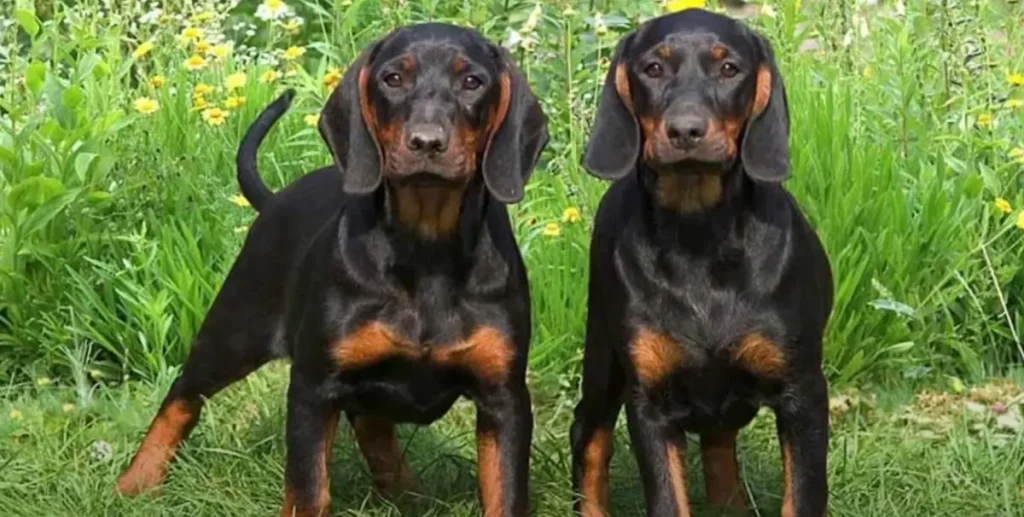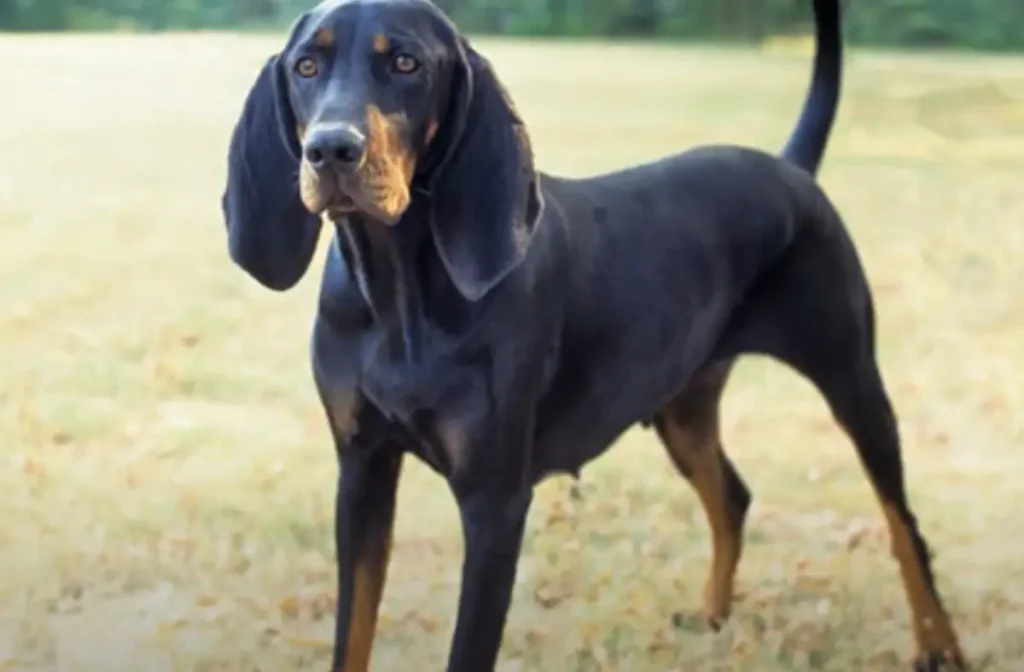Imagine a dog with a nose so powerful it could track a scent through a hurricane; that’s the Black and Tan Coonhound for you. With their striking coal-black coats accented with deep tan markings, these hounds cut a fine figure whether they’re on the trail or lounging at your feet.
You’ve likely noticed their long, droopy ears and soulful eyes, which are as functional as they are expressive; those ears help to waft scents towards their legendary nose, a tool that has carved their niche in hunting history.
Originating from the American Southeast, they have a storied past, intertwining with the development of the United States. As you consider this breed’s place in your life or your interest in canine history, you are standing at the threshold of a tale as rich and inviting as the hounds themselves.
What has shaped this breed’s distinctive temperament and skills, and how have they transitioned from relentless hunters to loyal companions? The answers lie in their storied past, a journey through time that has much to reveal about these captivating canines.
- Noise Level
- Energy
- Sociability
- Trainability
- Care
- Health
Overall
Summary
The Black and Tan Coonhound is known for its moderate noise level, high energy, friendly nature, decent trainability, moderate care needs, and generally good health.
Black and Tan Coonhound: Traits, Temperament, and Care Guide
Delving into the traits and temperament of the Black and Tan Coonhound, you’ll find a breed with a strong hunting lineage. They are characterized by their keen sense of smell, amiable nature, and a need for consistent, patient training.
They thrive on belonging to a pack with you or canine companions.
Their exercise and grooming needs are moderate but don’t underestimate their desire for a fulfilling daily exercise routine.
Exploring the Characteristics of the
Coonhound
Moving beyond the Black and Tan Coonhound’s general traits and temperament, let’s examine the specific characteristics that define this unique breed.
| Characteristic | Detail |
|---|---|
| Origin | United States |
| Size | Males 23-27″, Females 21-25″ |
| Coat | Black with tan markings |
| Ears | Long, drooping |
| Hunting History | Bred for treeing raccoons and possums |
These qualities make the Black and Tan Coonhound a distinctive member of the hunting dog community.
Coonhound: A Comprehensive Profile and Guide
You’re about to get an in-depth look at the Black and Tan Coonhound, a versatile and storied breed.
Their origins in the United States and their role in hunting raccoons highlight a rich history and a dynamic temperament.
Understanding their exercise needs, social behaviors, and training requirements will help determine if this breed fits your lifestyle.
Everything You Need to Know
Understanding the Black and Tan Coonhound begins with acknowledging its distinctive attributes. These include its impressive stature, typically ranging from 23 to 27 inches for males and 21 to 25 inches for females. The Black and Tan Coonhound is also adept in both companionship and hunting prowess.
- Adaptability: The Black and Tan Coonhound can thrive in apartments when well-behaved. Its size isn’t everything when it comes to adapting to different living situations.
- Sociable: This breed is generally friendly with other dogs. However, it does require patient training to ensure proper socialization.
- Health: The Black and Tan Coonhound is prone to hip dysplasia, a common health issue among larger dog breeds. Regular care and monitoring are necessary to maintain their overall well-being.
- Heritage: The Black and Tan Coonhound holds the distinction of being the first Coonhound recognized by the American Kennel Club. It has a rich hunting heritage dating back to the 1700s.
These characteristics and qualities contribute to a better understanding of the Black and Tan Coonhound as a breed.
Discovering the Temperament of Coonhounds
While the Black and Tan Coonhound is known for its loyalty and passion for work, its temperament is a blend of friendly outgoingness and independent tenacity, making it an excellent but sometimes challenging companion.
This breed’s intelligence and responsiveness shine through, yet its independence can appear as headstrong behavior. Early socialization is vital to harnessing its sociable nature and preventing any territorial tendencies from developing.

Coonhound: Is It a Good Fit for Families?
Considering a Black and Tan Coonhound as your family’s new addition? You’ll be pleased to know they’re generally great with kids and thrive in an active household, given their playful and energetic nature.
However, their strong hunting instincts and independence mean you’ll need a firm hand in training and a secure yard to keep them safe.
Assessing Coonhound’s Compatibility with Families and Kids
When evaluating if a Black and Tan Coonhound is the right addition to your family, it’s essential to consider their unique traits and how these may mesh with your household dynamics and lifestyle.
- Tolerates noisy homes, but assess any tendency to bark or howl.
- Needs secure fencing to curb wandering instincts.
- Craves exercise; suits active families.
- Outgoing and loyal; thrives with early socialization, especially around young kids.
Coonhound Apartment Living Adaptability
Adapting well to apartment living, Coonhounds require careful consideration of their needs for exercise and mental stimulation to ensure they’re content in a smaller space. Their high energy means daily exercise is a must, and when left alone, they should have activities to keep them occupied.
Prioritize qualities like being quiet and well-behaved, so you and your neighbors can enjoy a peaceful, harmonious community.
Coonhound Obedience Essentials
To ensure your Black and Tan Coonhound thrives, you must focus on effective training strategies tailored to their unique traits.
Since they’re bred for independence and a keen sense of smell, you must start with consistent training and socialization from a young age.
Leash training and daily exercise are non-negotiable to manage their scent-driven behavior and high energy levels.
Effective Training Strategies
Harnessing the Black and Tan Coonhound’s independent nature requires firm, consistent patient training strategies to ensure obedience and good behavior. You’ll want to engage with their independent streak through firm training, ensuring they’re well-behaved companions.
| Strategy | Purpose | Tips |
|---|---|---|
| Leash Training | Prevent scent-driven wandering | Start early, use rewards |
| Daily Exercise | Satisfy energy and instincts | Include play, long walks |
| Socialization | Reduce stubbornness | Early puppy classes, new experiences |
| Regular Ear Care | Prevent infections | Gentle cleaning, check-ups |
Coonhounds Exercise and Grooming Needs
For their well-being, Black and Tan Coonhounds need at least 40 minutes of daily exercise. This should be coupled with relatively low-maintenance grooming, including occasional brushing and regular ear cleanings. Utilize a grooming mitt to gently remove any shed fur, keeping their coat sleek.
Health Considerations for Coonhounds
As you consider a Black and Tan Coonhound your next companion, you must be aware of their health needs. They’re prone to hip dysplasia, a condition that can affect their mobility, and cataracts, which may impair vision as they age.
Ensure you’re obtaining your dog from a responsible breeder who provides health clearances for both parents to minimize the risk of genetic diseases.

Common Health Issues and Lifespan
When considering the health of your Black and Tan Coonhound, it’s essential to be aware that they may be prone to hip dysplasia and cataracts, among other conditions. Responsible breeders test for these health issues to ensure longevity.
With care, your companion’s life span can reach 10-12 years, fostering a deep bond built on mutual care and understanding.
Is Coonhound the Right Pet for You?
Deciding whether a Black and Tan Coonhound is the ideal pet for you requires careful consideration of its specific traits and your living situation.
As potential pet parents, assess your vocalization tolerance and ability to meet the breed’s high activity level. Remember, their tendency to wander demands secure living spaces, and their sensitivity level suits them to a harmonious home environment.
Conclusion
As you close this chapter on the Black and Tan Coonhound, consider it the Atticus Finch of dog breeds—noble, steadfast, and with a deep-rooted sense of purpose.
Whether it’s providing loyal companionship or showcasing its legendary hunting prowess, this breed embodies a rich heritage that resonates with dog lovers.
Remember, its health, happiness, and harmony with your family hinge on understanding and meeting its unique needs.
Embrace the journey with your Coonhound, a true American original.
Frequently Asked Questions
What Did Coonhounds Hunt?
Coonhounds excel at raccoon predation, using nocturnal tracking skills. They’re adept at scent discrimination, hunting possums and larger quarry like deer, and they have the innate prowess to hunt by scent.
What Characteristics Make Them Great Coon Hunting Dogs?
You need a dog with keen scent trailing, sharp night vision, and a strong treeing instinct to excel in coon hunting. These characteristics ensure success and foster a deep bond in the hunting duo.
Are Black and Tan Coonhounds Protective?
Black and Tan Coonhounds are protective, displaying strong guardian instincts. Their family loyalty often leads to territorial behavior, ensuring your home and loved ones are vigilantly watched over.
What Is the History of the Coon Dog?
You’re delving into a tapestry of Americana, where Coonhound origins intertwine with history. Breeding evolution from foxhounds and bloodhounds underpins their significance, crafting a legacy of loyal hunters and beloved companions.
